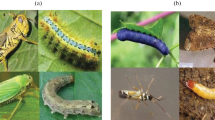Abstract
From the farmers’ perspective, it is very important to detect the beneficial and non-beneficial paddy pests for reducing the use of pesticides with increased productivity. In this chapter, a region-based deep convolutional neural network (Faster R-CNN) where a deep CNN is connected with a region proposal network (RPN) is used to perform the detection and identification paddy pests from the images. The main focus of this chapter is to find out not only harmful pests but also beneficial pests of paddy field so that farmers can make decisions when to use pesticides and when not to. A dataset with a large number of beneficial and harmful pests’ images from the paddy field was created for experimentation. Three models of Faster R-CNN based on ResNet-101, VGG-16, and MobileNet have been applied, and it is found that ResNet-101 gives the highest accuracy of 96.93% for beneficial and 95.07% for non-beneficial pest detection and identification compared to other networks.
Access this chapter
Tax calculation will be finalised at checkout
Purchases are for personal use only
Similar content being viewed by others
References
Agriculture, https://en.banglapedia.org/index.php?title=Agriculture#:~:text=Agricultural%20land%20The%20total%20land,and%20very%20lowland%20(2%25), last accessed 16 July 2020
Chowdhury, A.T., Chowdhury, S.S.: Performance Evaluation of Agricultural Banks in Bangladesh. Int. J. Bus. Manage. 6(4), 75–89 (2011)
Ahiduzzaman, M.: Rice husk energy technologies in Bangladesh. Agric. Eng. Int. CIGR Ej. 9 (2007)
Zadoks, C. J.: Crop loss assessment: a historical perspective and rationale. In: International Workshop on Crop Loss Assessment to Improve Pest Management in Rice and Rice-based Cropping Systems in South and Southeast Asia, pp. 1–9. International Rice Research Institute, Philippines (1990)
Fuentes, A., Yoon, S., Kim, S.C., Park, D.S.: A robust deep-learning-based detector for real-time tomato plant diseases and pest’s recognition. J. Sens. 17(9) (2017)
Sladojevic, S., Arsenovic, M., Anderla, A., Culibrk, D., Stefanovic, D.: Deep neural networks-based recognition of plant diseases by leaf image classification. Comput. Intell. Neurosci. (2016)
Karmokar, B.C., Ullah, M.S., Siddiquee, M.K., Alam, K. M. R.: Tea leaf diseases recognition using neural network ensemble. Int. J. Comput. Appl. 114(17) (2015)
Wang, G., Sun, Y., Wang, J.: Automatic image-based plant disease severity estimation using deep learning. Comput. Intell. Neurosci. (2017)
Huang, S., Fan, X., Sun, L., Shen, Y., Suo, X.: Research on classification method of maize seed defect based on machine vision. J. Sens. 1–9. Hindawi, London (2019)
Miah, S., Hoque, A., Paul, D., Rahman, D.: Unsafe use of pesticide and its impact on health of farmers: a case study in Burichong Upazila, Bangladesh. IOSR J. Environ. Sci. Toxicol. Food Technol. 8(1), 57–67 (2014)
Salahat, E., Qasaimeh, M.: Recent advances in features extraction and description algorithms: a comprehensive survey. In: Proceedings of the IEEE International Conference on Industrial Technology (ICIT), pp. 1059–1063 (2017)
Gutierrez, A., Ansuategi, A., Susperregi, L., Tubío, C., Rankić, I., Lenža, L.: A benchmarking of learning strategies for pest detection and identification on tomato plants for autonomous scouting robots using internal databases. J. Sens. 1–15 (2019)
Al-Saqer, S.M.: A robust recognition system for pecan weevil using artificial neural networks. Am. J. App. Sci. (2012)
Prathibha, G.P., Goutham, T., Tejaswini, M., Rajas, P.R., Balasubramani, K.: Early pest detection in tomato plantation using image processing. Int. J. Comput. Appl. 96(12), 22–24 (2014)
Zhang, X., Qiao, Y., Meng, F., Fan, C., Zhang, M.: Identification of Maize leaf diseases using improved deep convolutional neural networks. IEEE Access 6, 30370–30377 (2018)
Aryalekshmi, B.N., Rajashekar, B., Sushmitha, M.T.: Survey on deep learning architectures in identification of crop pests and diseases. Int. J. Adv. Sci. Technol. 29(10S), 8274–8281 (2020)
Nasiruddin, M., Roy, R.: Rice field insect pests during the RRCE growing seasons in two areas of Hathazari, Chittagong. Bangladesh J. Zool. 40(1), 89–100 (2012)
Pathak, M., Khan, Z.: Insect Pests OF RICE. International Rice Research Institute, Philippines (1994)
Brummer, B., Vleeschouwer, D.C.: Natural Image Noise Dataset. IEEE Xplore, Louvain-la-Neuve, Belgium (2020)
Deng, G., Cahill, L, W. An adaptive Gaussian filter for noise reduction and edge detection. In: Proceedings of Nuclear Science Symposium and Medical Imaging Conference, (1993)
Firdausy, K., Sutikno, T., Prasetyo, E.: Image enhancement using contrast stretching on RGB and IHS digital image. Telkomnika (Telecommunication Computing Electronics and Control), vol. 5, pp. 45, (2007)
Toyama, K., Krumm, J., Brumitt, B., Meyers, B.: Wallflower: principles and practice of background maintenance. In: Proceedings of the Seventh IEEE International Conference on Computer Vision 1999, vol. 1, pp. 255–261. Greece (1999)
Simard, P., Steinkraus, D., Platt, J.: Best practices for convolutional neural networks applied to visual document analysis. In: Seventh International Conference on Document Analysis and Recognition, Proceedings (2003)
Fukushima, K.: Neocognitron: a self-organizing neural network model for a mechanism of pattern recognition unaffected by shift in position. Biol. Cybern. 36(4), 193–202 (1980)
Voulodimos, A., Doulamis, N., Doulamis, A., Protopapadakis, E.: Deep learning for computer vision: a brief review. Comput. Intell. Neurosci. 2018, 1–13 (2018)
Tammina, S.: Transfer learning using VGG-16 with deep convolutional neural network for classifying images. Int. J. Sci. Res. Publ. (IJSRP) 9(10) (2019)
He, K., Zhang, X., Ren, S., Sun, J.: Deep residual learning for image recognition. In: 2016 IEEE Conference on Computer Vision and Pattern Recognition (CVPR) (2016)
Howard, A., Zhu, M., Chen, B., Kalenichenko, D., Wang, W., Weyand, T., Adam, H.: MobileNets: Efficient Convolutional Neural Networks for Mobile Vision Applications, https://arxiv.org/abs/1704.04861, last accessed 19 July 2020
Hasan, M.Z., Hasan, K.M.Z., Sattar, A.: burst header packet flood detection in optical burst switching network using deep learning model. Proc. Comput. Sci. 14, 970–977 (2018)
Author information
Authors and Affiliations
Corresponding author
Editor information
Editors and Affiliations
Rights and permissions
Copyright information
© 2021 The Author(s), under exclusive license to Springer Nature Singapore Pte Ltd.
About this chapter
Cite this chapter
Hasan, M., Zeba, N., Shorif, S.B., Akter, M. (2021). Deep Learning-Based Essential Paddy Pests' Filtration Technique for Economic Damage Management. In: Uddin, M.S., Bansal, J.C. (eds) Computer Vision and Machine Learning in Agriculture. Algorithms for Intelligent Systems. Springer, Singapore. https://doi.org/10.1007/978-981-33-6424-0_4
Download citation
DOI: https://doi.org/10.1007/978-981-33-6424-0_4
Published:
Publisher Name: Springer, Singapore
Print ISBN: 978-981-33-6423-3
Online ISBN: 978-981-33-6424-0
eBook Packages: Intelligent Technologies and RoboticsIntelligent Technologies and Robotics (R0)




